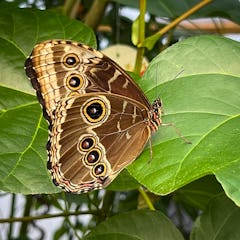History and Overview
Today, the zoo is home to over 750 different animal species and serves as an attraction and a conservation centre. Its mission is to raise awareness about nature conservation and offer visitors the chance to learn about animals and their habitats. The zoo also holds historical significance—for example, the famous bear Winnie, who inspired A. A. Milne’s Winnie-the-Pooh, lived there.
Areas and Highlights
The zoo is divided into several themed zones where visitors can explore different animal species and their environments:
Land of the Lions resembles an Indian national park and houses five Asiatic lions, three of which were born in 2024. Visitors can comfortably watch the lions and their cubs from a distance.
Tiger Territory is home to four Sumatran tigers and is designed to mimic their natural Indonesian habitat. The enclosure includes trees and poles for the tigers to express their natural behaviour. Visitors can get up close, safely behind glass.
Gorilla Kingdom features a climbing area and a gorilla island where the gorillas can climb and do activities such as searching for food hidden by their caretakers.
Penguin Beach is home to Humboldt penguins and is built to resemble a South American beach. It’s a popular spot to watch the penguins on land and in a large pool. The penguins are fed twice a day, drawing a big crowd each time.
Rainforest Life is an indoor tropical exhibit modelled after a South American rainforest. Monkeys, sloths, bats, and other animals roam freely and sometimes get up close to visitors.
Tiny Giants showcases land and aquatic invertebrates, such as spiders and various fish. In with the Spiders is a space inhabited by spiders that you can walk through and even take a selfie at the spider mirror at the end.
Butterfly Paradise is a tropical butterfly exhibit with hundreds of free-flying species.
Bird Safari is a walkthrough aviary featuring exotic birds, some of which are extinct in the wild.
Blackburn Pavilion recreates a rainforest-like environment with beautiful and colourful birds, offering an Amazon-like experience.
Reptile House is famous for its reptiles, such as snakes and crocodiles, and is known from the Harry Potter films.
Giants of the Galapagos is where you can see giant Galapagos tortoises.
Night Life is an exhibit featuring nocturnal animals like bats and hedgehogs.
In with the Lemurs takes visitors into Madagascar’s forests, where they can observe lemurs—of which only around 2,000 remain in the wild.
Into Africa features large African animals like giraffes, zebras, and pygmy hippos, which number only about 2,500 in the wild. You can also book a separate giraffe keeper experience (£95 for 90 minutes), where you help clean the enclosure and prepare and possibly feed the animals.
Komodo Dragon House houses the zoo’s Komodo dragons, which can be viewed through a glass wall.
Meerkats live in an area designed to resemble the Kalahari Desert.
Monkey Valley is a new enclosure where black-and-white colobus monkeys climb 20 meters high, leap between trees, and swing from ropes. Visitors can walk underneath the area and watch their behaviour up close.
The Secret Life of Reptiles and Amphibians is another new attraction featuring snakes, crocodiles, salamanders, and more. You can explore the animals from a researcher’s perspective. Only about 120 Philippine crocodiles and just 50 individuals of a certain turtle species remain in the wild.
Visiting Tips
The zoo is open daily, typically from 10:00 AM to 5:00 PM, though summer hours may be extended.
Tickets
Ticket prices vary by season and visitor age. The cheapest option is to buy in advance online. Discounts are available for children, students, and seniors. ZSL members get free admission.
Services and Experiences
The zoo has restaurants, cafés, and picnic areas for meals or packed lunches. Due to the zoo’s large area, comfortable walking shoes are recommended. Check feeding and show times in advance to catch the highlights. The zoo is fully accessible to visitors with mobility issues. The gift shop’s proceeds support conservation efforts. The London Zoo Lodges is a special treat, where you can sleep near the lions and join private evening tours.
You can also get closer to many animals by purchasing a zookeeper experience ticket, which is a 90-minute session during which you help care for the animals or their habitats. More info on these tours is available here.
Summary
London Zoo is a diverse and educational destination for all ages. It combines an exciting visit with important conservation work, offering a unique chance to encounter animals right near the heart of the city.














